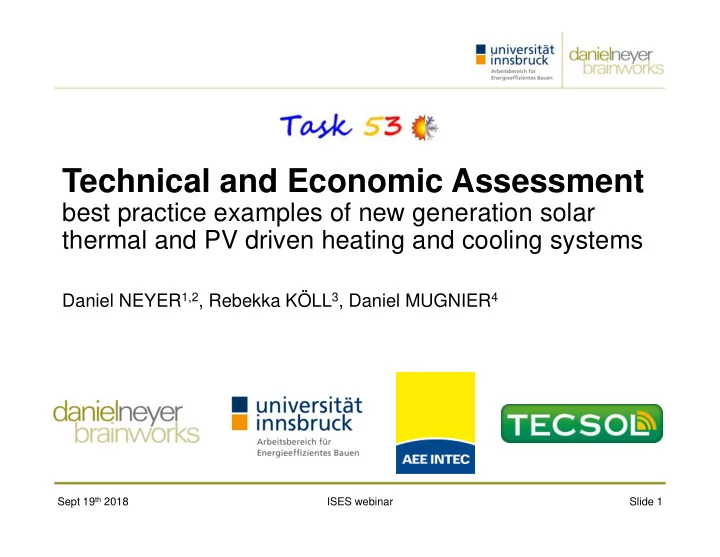

Technical and Economic Assessment best practice examples of new generation solar thermal and PV driven heating and cooling systems Daniel NEYER 1,2 , Rebekka KÖLL 3 , Daniel MUGNIER 4 Sept 19 th 2018 ISES webinar Slide 1
Introduction Solar cooling and heating can be complex Solar Thermal or Photovoltaic driven System design & configurations (backups, storages,…) Demands (domestic hot water, space cooling, …) … Assessment in a common comparable format energetic, ecological, economic, evaluation T53E4 Assessment Tool Assessment based on (monthly) energy balances Measured or simulated (sub) system Data base for Technical and Economic assessment Sept 19 th 2018 ISES webinar Slide 2
Introduction Solar cooling and heating can be complex Solar Thermal or Photovoltaic driven System design & configurations (backups, storages,…) Demands (domestic hot water, space cooling, …) … Assessment in a common comparable format energetic, ecological, economic, evaluation T53E4 Assessment Tool Assessment based on (monthly) energy balances Measured or simulated (sub) system Data base for Technical and Economic assessment Sept 19 th 2018 ISES webinar Slide 3
(( (( (( (( Technical Key Figures Non-renewable primary energy ratio (PER NRE ) Energy input ( � �� ) converted in primary energy ∑ � :;< electricity: ε el = 0.4 kWh Use /kWh PE.NRE ��� ��� � ∑ � �=,�� + � �� natural gas: ε in = 0.9 kWh Use /kWh PE.NRE � �= � �� Standardized Task 53 reference system Natural gas boiler, air-cooled vapor compression chiller ∑ Q %&' PER ���. !" � SPF 8. !" ∗ � !, + Q !,, !" ∑ Q %&'.)!*' + Q ,%--. !" Q %&'.4%,5 + � ./ ∗ η 23. !" � !, Non-renewable primary energy savings ( f sav.PER-NRE ) ���.������� � 1 � ��� ���.��� � ��� ���.��� Sept 19 th 2018 ISES webinar Slide 4
Economic Key figures Annuity method & input values based on EN-standards Standardized (data base) to calculate annualized costs Investment, replacement & residual value Maintenance & service, Operational costs (energy, water) Solar Heating and Cooling and Reference Levelized cost of energy CostRatio (CR) CostRatioDCRE � FGGHFIJKLM OPQRQ STU FGGHFIJKLM OPQR ��V Sept 19 th 2018 ISES webinar Slide 5
Overview Examples Assessment of 28 SHC plants with T53E4 Tool 17 examples (28 configurations) System & Subsystem Analysis Trend analysis Sensitivity analysis Sept 19 th 2018 ISES webinar Slide 6
Overview Examples Sept 19 th 2018 ISES webinar Slide 7
Results obtained Assessment of 28 SHC plants with T53E4 Tool o Technical analysis − Energy balance check − Comparison to T53 Standard − System & Subsystem Analysis − PER NRE , PER NRE.ref , f sav.NRE , SPF equ o Economic analysis − Investment, Replacement & Residual − Maintenance, Energy (electricity, natural gas,…) − Comparison to T53 Standard − Spec. Invest, LCOE SHC , LCOE REF , CR Trend analysis Sensitivity analysis Sept 19 th 2018 ISES webinar Slide 8
Summary Result Exclude plants with no annual energy balance Sept 19 th 2018 ISES webinar Slide 9
Trend analyses Many different configurations / boundaries Size / demand / technology / data source / location… Clustering of results south/northern location PV and ST supported systems Sept 19 th 2018 ISES webinar Slide 10
Trend analyses Many different configurations / boundaries Location & technology Sept 19 th 2018 ISES webinar Slide 11
Trend analyses Many different configurations / boundaries Location & technology Sept 19 th 2018 ISES webinar Slide 12
Sensitivity analyses Influence of chosen boundaries Investment, Electricity, Natural Gas price Auxiliary demand, Energy output, Non-renewable primary energy conversion factors Influence shown on trends Sept 19 th 2018 ISES webinar Slide 13
Sensitivity analyses Influence of chosen boundaries Investment cost Auxiliary demand, Energy output, Non-renewable primary energy conversion factors Influence shown on trends Sept 19 th 2018 ISES webinar Slide 14
Sensitivity analyses Influence of chosen boundaries Investment cost Sept 19 th 2018 ISES webinar Slide 15
Summary T53E4 Assessment Tool Simplified analysis of system / subsystem Useful for benchmarking against reference and other RE Focus on non-renewable primary energy (fsav.NRE) Cost Ratio Performance of SHC examples Non-renewable Primary Energy Savings 40-80% Higher savings lead to higher costs Economics are mainly investment dominated Simplification and component reduction !! Sept 19 th 2018 ISES webinar Slide 16
Summary Sensitivity analysis Effect of changes in boundaries Trend wise comparison of results Large differences for different systems sensitivity for certain type of systems to follow soon Advantage of ST or PV is depending on … Local conditions System design & Application Both technologies can be optimized Cost competitiveness can be reached Sept 19 th 2018 ISES webinar Slide 17
Thank you for your attention! Sept 19 th 2018 ISES webinar Slide 18
Recommend
More recommend